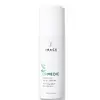What's inside
What's inside
 Key Ingredients
Key Ingredients

 Benefits
Benefits

 Concerns
Concerns

 Ingredients Side-by-side
Ingredients Side-by-side

Aloe Barbadensis Leaf Juice
Skin ConditioningWater
Skin ConditioningSodium C14-16 Olefin Sulfonate
CleansingCocamidopropyl Hydroxysultaine
CleansingGlycerin
HumectantVitis Vinifera Fruit Water
Skin ConditioningSodium Cocoamphoacetate
CleansingSodium Chloride
MaskingPropanediol
SolventSorbitol
HumectantPhenoxyethanol
PreservativePolysorbate 20
EmulsifyingCaprylic/Capric Triglyceride
MaskingLeuconostoc/Radish Root Ferment Filtrate
AntimicrobialCitric Acid
BufferingGlycolipids
Skin ConditioningEthylhexylglycerin
Skin ConditioningCopper PCA
HumectantPanthenol
Skin ConditioningSodium Hyaluronate
HumectantCamellia Sinensis Leaf Extract
AntimicrobialAmyl Cinnamal
PerfumingLimonene
PerfumingArctium Lappa Root Extract
Skin ConditioningCurcuma Longa Root Extract
MaskingNelumbo Nucifera Flower Extract
Skin ConditioningTamarindus Indica Fruit Extract
Skin ConditioningTrifolium Pratense Flower Extract
AstringentCalendula Officinalis Flower Extract
MaskingPrunus Armeniaca Fruit Extract
Skin ConditioningCitrus Aurantium Dulcis Fruit Extract
MaskingCitrus Limon Peel Extract
EmollientJuniperus Virginiana Wood Extract
PerfumingMusa Sapientum Fruit Extract
Skin ConditioningPyrus Malus Fruit Extract
Skin ConditioningCocos Nucifera Fruit Extract
EmollientSodium Benzoate
MaskingCoffea Arabica Leaf/Seed Extract
MaskingRubus Idaeus Fruit Extract
AstringentCitrus Paradisi Fruit Extract
Skin ConditioningCucumis Melo Fruit Extract
Skin ConditioningAnanas Sativus Fruit Extract
Skin ConditioningButter Extract
EmollientFragaria Chiloensis Fruit Extract
Skin ConditioningPrunus Amygdalus Dulcis Fruit Extract
Skin ConditioningVanilla Planifolia Fruit Extract
Skin ConditioningBiosaccharide Gum-1
HumectantSodium Levulinate
Skin ConditioningGlyceryl Caprylate
EmollientSodium Anisate
AntimicrobialTocopherol
AntioxidantAloe Barbadensis Leaf Juice, Water, Sodium C14-16 Olefin Sulfonate, Cocamidopropyl Hydroxysultaine, Glycerin, Vitis Vinifera Fruit Water, Sodium Cocoamphoacetate, Sodium Chloride, Propanediol, Sorbitol, Phenoxyethanol, Polysorbate 20, Caprylic/Capric Triglyceride, Leuconostoc/Radish Root Ferment Filtrate, Citric Acid, Glycolipids, Ethylhexylglycerin, Copper PCA, Panthenol, Sodium Hyaluronate, Camellia Sinensis Leaf Extract, Amyl Cinnamal, Limonene, Arctium Lappa Root Extract, Curcuma Longa Root Extract, Nelumbo Nucifera Flower Extract, Tamarindus Indica Fruit Extract, Trifolium Pratense Flower Extract, Calendula Officinalis Flower Extract, Prunus Armeniaca Fruit Extract, Citrus Aurantium Dulcis Fruit Extract, Citrus Limon Peel Extract, Juniperus Virginiana Wood Extract, Musa Sapientum Fruit Extract, Pyrus Malus Fruit Extract, Cocos Nucifera Fruit Extract, Sodium Benzoate, Coffea Arabica Leaf/Seed Extract, Rubus Idaeus Fruit Extract, Citrus Paradisi Fruit Extract, Cucumis Melo Fruit Extract, Ananas Sativus Fruit Extract, Butter Extract, Fragaria Chiloensis Fruit Extract, Prunus Amygdalus Dulcis Fruit Extract, Vanilla Planifolia Fruit Extract, Biosaccharide Gum-1, Sodium Levulinate, Glyceryl Caprylate, Sodium Anisate, Tocopherol
 Reviews
Reviews

Alternatives
Ingredients Explained
These ingredients are found in both products.
Ingredients higher up in an ingredient list are typically present in a larger amount.
Citric Acid is an alpha hydroxy acid (AHA) naturally found in citrus fruits like oranges, lemons, and limes.
Like other AHAs, citric acid can exfoliate skin by breaking down the bonds that hold dead skin cells together. This helps reveal smoother and brighter skin underneath.
However, this exfoliating effect only happens at high concentrations (20%) which can be hard to find in cosmetic products.
Due to this, citric acid is usually included in small amounts as a pH adjuster. This helps keep products slightly more acidic and compatible with skin's natural pH.
In skincare formulas, citric acid can:
While it can provide some skin benefits, research shows lactic acid and glycolic acid are generally more effective and less irritating exfoliants.
Most citric acid used in skincare today is made by fermenting sugars (usually from molasses). This synthetic version is identical to the natural citrus form but easier to stabilize and use in formulations.
Read more about some other popular AHA's here:
Learn more about Citric AcidPhenoxyethanol is a preservative that has germicide, antimicrobial, and aromatic properties. Studies show that phenoxyethanol can prevent microbial growth. By itself, it has a scent that is similar to that of a rose.
It's often used in formulations along with Caprylyl Glycol to preserve the shelf life of products.
Sodium Benzoate is a preservative. It's used in both cosmetic and food products to inhibit the growth of mold and bacteria. It is typically produced synthetically.
Both the US FDA and EU Health Committee have approved the use of sodium benzoate. In the US, levels of 0.1% (of the total product) are allowed.
Sodium benzoate works as a preservative by inhibiting the growth of bacteria inside of cells. It prevents the cell from fermenting a type of sugar using an enzyme called phosphofructokinase.
It is the salt of benzoic acid. Foods containing sodium benzoate include soda, salad dressings, condiments, fruit juices, wines, and snack foods.
Studies for using ascorbic acid and sodium benzoate in cosmetics are lacking, especially in skincare routines with multiple steps.
We always recommend speaking with a professional, such as a dermatologist, if you have any concerns.
Learn more about Sodium BenzoateChances are, you eat sodium chloride every day. Sodium Chloride is also known as table salt.
This ingredient has many purposes in skincare: thickener, emulsifier, and exfoliator.
You'll most likely find this ingredient in cleansers where it is used to create a gel-like texture. As an emulsifier, it also prevents ingredients from separating.
There is much debate on whether this ingredient is comedogenic. The short answer - comedogenic ratings don't tell the whole story. Learn more about comegodenic ratings here.
The concensus about this ingredient causing acne seems to be divided. Research is needed to understand if this ingredient does cause acne.
Scrubs may use salt as the primary exfoliating ingredient.
Learn more about Sodium ChlorideWater. It's the most common cosmetic ingredient of all. You'll usually see it at the top of ingredient lists, meaning that it makes up the largest part of the product.
So why is it so popular? Water most often acts as a solvent - this means that it helps dissolve other ingredients into the formulation.
You'll also recognize water as that liquid we all need to stay alive. If you see this, drink a glass of water. Stay hydrated!
Learn more about Water